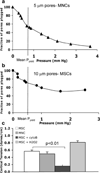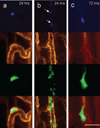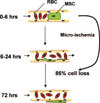Fate of culture-expanded mesenchymal stem cells in the microvasculature: in vivo observations of cell kinetics
- PMID: 19096027
- PMCID: PMC3700384
- DOI: 10.1161/CIRCRESAHA.108.187724
Fate of culture-expanded mesenchymal stem cells in the microvasculature: in vivo observations of cell kinetics
Abstract
Vascular delivery of mesenchymal stem cells (MSCs) following myocardial infarction is under clinical investigation. Little is known about the microvascular fate of MSCs. We used intravital microscopy of rat cremaster muscle microcirculation to track intraarterially delivered MSCs. Rat MSCs (average diameter, 23 microm) were bolused into the ipsilateral common iliac artery. Interrogation of an arteriole-venule pair revealed that 92+/-7% (n=6) of MSCs arrest and interrupt flow during first pass at the precapillary level, resulting in decreased flow in the feeding arteriole (velocity decreased from 6.3+/-1.0 to 4.6+/-1.3 mm/sec; P<0.001). MSC deformability evaluated using filtration through polycarbonate membranes revealed that the cortical tension of MSCs (0.49+/-0.07 dyne/cm, n=9) was not different from that of circulating mononuclear cells (0.50+/-0.05 dyne/cm, n=7). When intravital microscopy was performed 3 days following injection, the number of MSCs in the cremaster further decreased to 14% of the initial number, because of cell death in situ. In vivo labeling of the basement membrane revealed that at 1 day, the surviving cells were spread out on the luminal side of the microvessel, whereas at 3 days, they integrated in the microvascular wall. Despite their deformability, intraarterially delivered MSCs entrap at the precapillary level because of their large size, with a small proportion of surviving MSCs integrating in a perivascular niche.
Figures






Comment in
-
Where have all the stem cells gone?Circ Res. 2009 Feb 13;104(3):280-1. doi: 10.1161/CIRCRESAHA.108.192641. Circ Res. 2009. PMID: 19213961 Free PMC article. No abstract available.
References
-
- Caplan AI, Dennis JE. Mesenchymal stem cells as trophic mediators. J Cell Biochem. 2006;98:1076–1084. - PubMed
-
- Gnecchi M, He H, Noiseux N, Liang OD, Zhang L, Morello F, Mu H, Melo LG, Pratt RE, Ingwall JS, Dzau VJ. Evidence supporting paracrine hypothesis for Akt-modified mesenchymal stem cell-mediated cardiac protection and functional improvement. FASEB J. 2006;20:661–669. - PubMed
-
- Pittenger MF, Mackay AM, Beck SC, Jaiswal RK, Douglas R, Mosca JD, Moorman MA, Simonetti DW, Craig S, Marshak DR. Multilineage potential of adult human mesenchymal stem cells. Science. 1999;284:143–147. - PubMed
-
- Jones E, McGonagle D. Human bone marrow mesenchymal stem cells in vivo. Rheumatology (Oxford) 2008;47:126–131. - PubMed
-
- Le Blanc K, Frassoni F, Ball L, Locatelli F, Roelofs H, Lewis I, Lanino E, Sundberg B, Bernardo ME, Remberger M, Dini G, Egeler RM, Bacigalupo A, Fibbe W, Ringdén O. Mesenchymal stem cells for treatment of steroid-resistant, severe, acute graft-versus-host disease: a phase II study. Lancet. 2008;371:1579–1586. - PubMed
Publication types
MeSH terms
Grants and funding
LinkOut - more resources
Full Text Sources
Other Literature Sources

